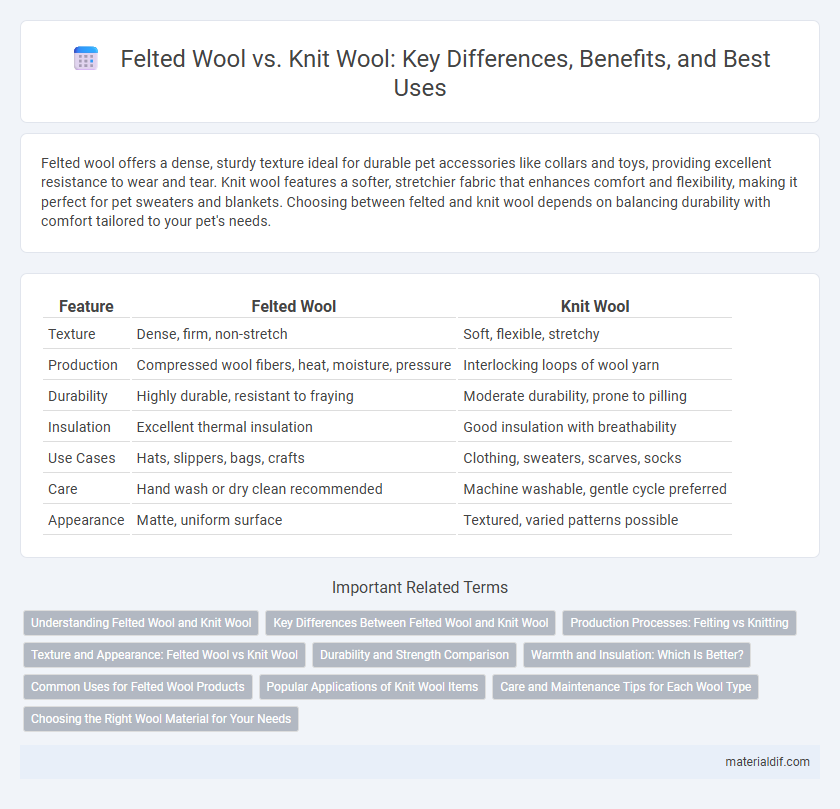Felted wool offers a dense, sturdy texture ideal for durable pet accessories like collars and toys, providing excellent resistance to wear and tear. Knit wool features a softer, stretchier fabric that enhances comfort and flexibility, making it perfect for pet sweaters and blankets. Choosing between felted and knit wool depends on balancing durability with comfort tailored to your pet's needs.
Table of Comparison
| Feature | Felted Wool | Knit Wool |
|---|---|---|
| Texture | Dense, firm, non-stretch | Soft, flexible, stretchy |
| Production | Compressed wool fibers, heat, moisture, pressure | Interlocking loops of wool yarn |
| Durability | Highly durable, resistant to fraying | Moderate durability, prone to pilling |
| Insulation | Excellent thermal insulation | Good insulation with breathability |
| Use Cases | Hats, slippers, bags, crafts | Clothing, sweaters, scarves, socks |
| Care | Hand wash or dry clean recommended | Machine washable, gentle cycle preferred |
| Appearance | Matte, uniform surface | Textured, varied patterns possible |
Understanding Felted Wool and Knit Wool
Felted wool is created by matting, condensing, and pressing wool fibers together, resulting in a dense, non-woven fabric known for its durability and insulating properties. Knit wool, on the other hand, is made by interlocking loops of yarn with needles, producing a flexible, stretchy textile that is breathable and often used in garments requiring elasticity. Understanding the structural differences helps in choosing felted wool for robust applications like outerwear and crafts, while knit wool suits apparel needing comfort and mobility.
Key Differences Between Felted Wool and Knit Wool
Felted wool is created by matting and compressing wool fibers, resulting in a dense, sturdy fabric with limited stretch and a smooth surface, ideal for insulation and structured items. Knit wool is produced by interlocking loops of yarn, offering elasticity, breathability, and a softer texture, commonly used in garments requiring flexibility and comfort. The main differences lie in their texture, flexibility, and construction methods, influencing their range of applications in fashion and home textiles.
Production Processes: Felting vs Knitting
Felted wool is produced by applying heat, moisture, and pressure to wool fibers, causing them to mat and interlock into a dense, non-woven fabric, whereas knit wool involves interlooping yarns through needles to create a flexible, open-textured fabric. Felting compresses individual fibers, resulting in a sturdy, insulating material ideal for outerwear and crafts. In contrast, knitting allows for elasticity and breathability, making knit wool perfect for garments like sweaters and scarves.
Texture and Appearance: Felted Wool vs Knit Wool
Felted wool features a dense, smooth texture achieved by matting and compressing wool fibers, resulting in a firm, non-stretch fabric with a uniform appearance often used for structured garments and accessories. Knit wool displays a flexible, textured surface created by interlocking loops of yarn, offering elasticity and a visibly patterned structure ideal for sweaters and scarves. The tactile difference is distinct: felted wool feels compact and sturdy, while knit wool is soft and pliable with pronounced stitch definition.
Durability and Strength Comparison
Felted wool features a dense, non-woven structure created by matting fibers together, resulting in superior durability and resistance to wear compared to knit wool, which has an interlaced loop construction more prone to stretching and snagging. The compressed nature of felted wool enhances its strength, making it ideal for heavy-duty applications such as outerwear and upholstery. Knit wool offers greater flexibility and breathability but generally lacks the robustness found in felted wool, making it less suitable for high-stress uses.
Warmth and Insulation: Which Is Better?
Felted wool offers superior warmth and insulation due to its dense, tightly compressed fibers that trap heat effectively and block wind. Knit wool, while breathable and flexible, has open loops that allow more air circulation, making it less insulating in extreme cold conditions. For maximum thermal retention in harsh weather, felted wool outperforms knit wool by providing enhanced heat retention and wind resistance.
Common Uses for Felted Wool Products
Felted wool products are commonly used in crafting durable items such as slippers, hats, and bags due to their dense, sturdy texture that resists fraying. This material is also popular for making insulation pads, protective cases, and decorative home furnishings like coasters and rugs. Felted wool's unique compact structure provides warmth and water resistance, making it ideal for practical and fashion-oriented applications.
Popular Applications of Knit Wool Items
Knit wool items are widely popular in apparel and home textiles due to their elasticity and breathability, making them ideal for sweaters, scarves, and socks. The interlocking yarn loops in knit wool enhance insulation while allowing flexibility, supporting activities in colder climates and activewear needs. Its versatility extends to cozy blankets and cushion covers, where durability and softness are essential for comfort and everyday use.
Care and Maintenance Tips for Each Wool Type
Felted wool requires gentle hand washing with cold water and mild detergent to maintain its dense texture and prevent shrinkage, while avoiding wringing or twisting to preserve its shape. Knit wool benefits from laundering in lukewarm water on a delicate cycle, preferably using a wool-specific detergent, and should be laid flat to dry to avoid stretching or distortion. Proper storage in a cool, dry place and regular airing help protect both felted and knit wool garments from moth damage and maintain their longevity.
Choosing the Right Wool Material for Your Needs
Felted wool offers a dense, durable texture that is ideal for insulation, crafts, and structured garments, providing excellent warmth and water resistance. Knit wool delivers superior stretch and breathability, making it perfect for comfortable clothing like sweaters, scarves, and activewear. Selecting between felted and knit wool depends on your need for rigidity versus flexibility, as well as the desired warmth and moisture management properties.
Felted Wool vs Knit Wool Infographic

 materialdif.com
materialdif.com